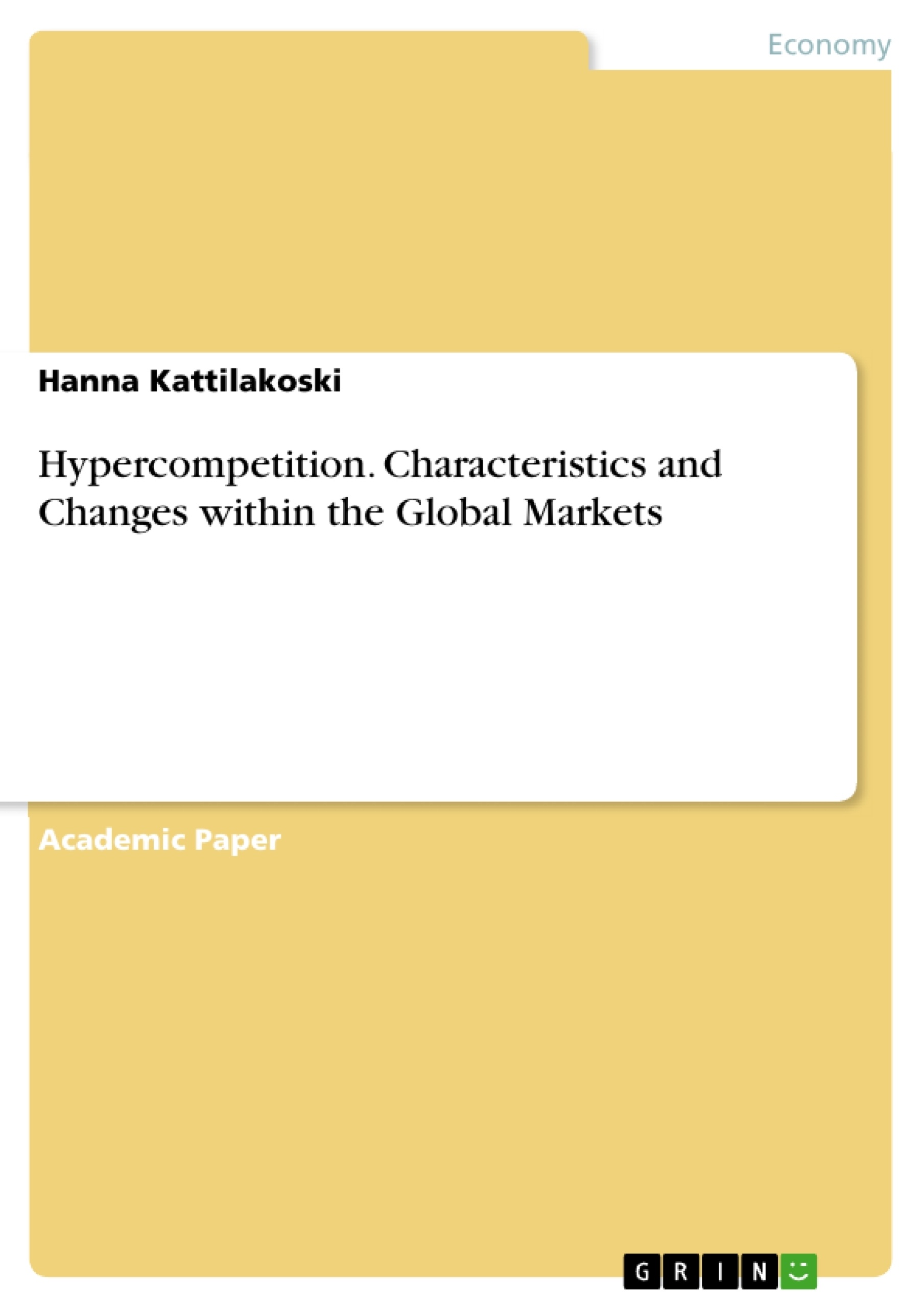This paper seeks to understand the characteristics of hypercompetition as well as the resulting changes that have occurred within the global markets.
Hypercompetition is a phenomenon that has recently impacted markets everywhere. It is the state of rapid competition occurring in markets, which is often characterized by an unsustainable competitive advantage.
In fact, many people believe that the concept of sustainable competitive advantage is no longer relevant. One of the main supporters of this idea and the man who coined the idea of hypercompetition is Richard D’Aveni, a professor of business strategy. He says that the idea of sustained competitive advantage is dead.
Table of Contents
- 1 Introduction
- 1.1 The Traditional Market
- 1.2 The Current Market
- 2 Characteristics of Hypercompetition
- 2.1 Driving Forces of Hypercompetition
- 2.1.1 Customer Changes
- 2.1.2 Technological Change
- 2.1.3 Falling Industry Boundaries
- 2.2 The Global Economy
- 2.3 Market Disruption
- 3 Changes within Industries
- 3.1 ICT TIMES Industry
- 3.2 Automotive Industry
- 3.3 Life Sciences Industry
- 4 Emergence of Cross-Industrial Players
- 4.1 Amazon
- 4.2 5G Automotive Association
- 4.3 Google
- 5 Four Arenas of Competition
- 5.1 Price/Quality
- 5.2 Know-how/Timing
- 5.3 Stronghold Creation/Invasion
- 6 Challenges with Hypercompetition
- 6.1 No Sustainable Competitive Advantage
- 6.2 Increases in Competition
- 6.3 Constant Change
- 7 Conclusions
- 8 References
Objectives and Key Themes
This paper aims to explore the characteristics of hypercompetition and its impact on global markets. It examines the shift from traditional, slow-moving markets to a current environment defined by rapid change, instability, and constant disruption. The paper analyzes the driving forces behind hypercompetition and explores its effects on various industries.
- The nature of hypercompetition and its defining features.
- The driving forces behind hypercompetition, including technological advancements, evolving customer preferences, and globalization.
- The impact of hypercompetition on industries and the emergence of cross-industrial players.
- The challenges posed by hypercompetition, such as the lack of sustainable competitive advantage and the need for constant adaptation.
- The changing dynamics of competition in the global marketplace.
Chapter Summaries
1 Introduction: This introductory chapter sets the stage by defining hypercompetition as a state of rapid and intense competition characterized by unsustainable competitive advantages. It contrasts the traditional market model, focused on stable oligopolies and sustainable competitive advantages, with the current dynamic market landscape where competition is relentless and continuous.
2 Characteristics of Hypercompetition: This chapter delves into the core attributes of hypercompetition. It explores the concept's enduring relevance despite its emergence in the 1990s, highlighting how hypercompetitors continually create and destroy competitive advantages, leading to market instability. The chapter links the rise of hypercompetition with significant merger and acquisition activity, globalization, and the growing importance of shareholder value.
2.1 Driving Forces of Hypercompetition: This section identifies four primary drivers of hypercompetition: changing customer preferences (fragmentation and demand for increased value), rapid technological change (creating new opportunities and disrupting existing models), decreasing industry boundaries (due to globalization and reduced entry barriers), and the presence of financially powerful competitors (“deep pockets”). Each driver is examined in detail, illustrating its contribution to the hypercompetitive environment.
Frequently Asked Questions: A Comprehensive Language Preview
What is the overall topic of this document?
This document provides a comprehensive preview of a paper exploring the characteristics of hypercompetition and its impact on global markets. It analyzes the shift from traditional markets to a rapidly changing, unstable, and constantly disrupted environment.
What topics are covered in the Table of Contents?
The table of contents includes: an introduction to traditional and current markets; characteristics of hypercompetition and its driving forces (customer changes, technological change, falling industry boundaries, the global economy, and market disruption); changes within specific industries (ICT, automotive, and life sciences); the emergence of cross-industrial players (Amazon, 5G Automotive Association, Google); four arenas of competition (price/quality, know-how/timing, stronghold creation/invasion); challenges with hypercompetition (lack of sustainable competitive advantage, increased competition, constant change); conclusions; and references.
What are the key objectives and themes of the paper?
The paper aims to explore the nature of hypercompetition and its defining features; the driving forces behind it (technological advancements, evolving customer preferences, and globalization); its impact on industries and the emergence of cross-industrial players; the challenges posed by hypercompetition (lack of sustainable competitive advantage and the need for constant adaptation); and the changing dynamics of competition in the global marketplace.
What are the main points discussed in the chapter summaries?
The chapter summaries cover the definition of hypercompetition and its contrast with traditional markets; a deeper dive into the core attributes of hypercompetition, its enduring relevance, and its link to merger and acquisition activity, globalization, and shareholder value; and a detailed examination of the four primary driving forces behind hypercompetition: changing customer preferences, rapid technological change, decreasing industry boundaries, and powerful competitors.
Which industries are specifically analyzed in the paper?
The paper specifically analyzes the ICT, automotive, and life sciences industries to illustrate the impact of hypercompetition.
Which companies are highlighted as examples of cross-industrial players?
Amazon, the 5G Automotive Association, and Google are highlighted as examples of companies operating across multiple industries.
What are the four arenas of competition discussed in the paper?
The four arenas of competition identified are price/quality, know-how/timing, and stronghold creation/invasion.
What are the main challenges associated with hypercompetition?
The main challenges associated with hypercompetition are the lack of sustainable competitive advantage, increases in competition, and the need for constant adaptation to a rapidly changing environment.
- Quote paper
- Hanna Kattilakoski (Author), 2017, Hypercompetition. Characteristics and Changes within the Global Markets, Munich, GRIN Verlag, https://www.grin.com/document/594216




